10 Reaction Equations
- 格式:pdf
- 大小:104.76 KB
- 文档页数:12
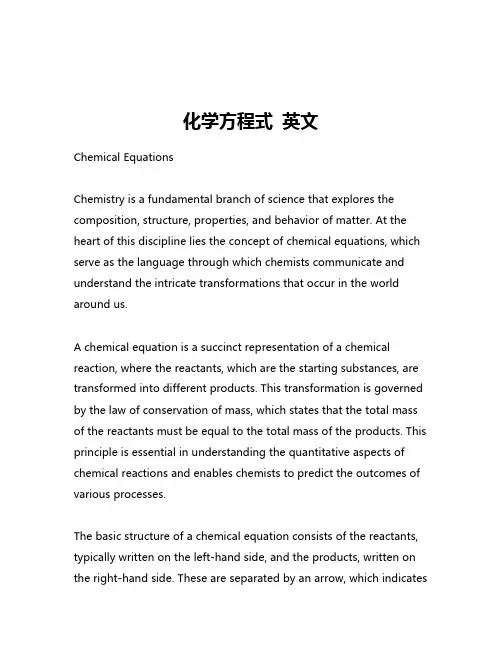
化学方程式英文Chemical EquationsChemistry is a fundamental branch of science that explores the composition, structure, properties, and behavior of matter. At the heart of this discipline lies the concept of chemical equations, which serve as the language through which chemists communicate and understand the intricate transformations that occur in the world around us.A chemical equation is a succinct representation of a chemical reaction, where the reactants, which are the starting substances, are transformed into different products. This transformation is governed by the law of conservation of mass, which states that the total mass of the reactants must be equal to the total mass of the products. This principle is essential in understanding the quantitative aspects of chemical reactions and enables chemists to predict the outcomes of various processes.The basic structure of a chemical equation consists of the reactants, typically written on the left-hand side, and the products, written on the right-hand side. These are separated by an arrow, which indicatesthe direction of the reaction. For example, the reaction between hydrogen gas and oxygen gas to form water can be represented as:2H2 + O2 → 2H2OIn this equation, the reactants are hydrogen gas (H2) and oxygen gas (O2), and the product is water (H2O). The numbers in front of the chemical formulas, known as stoichiometric coefficients, represent the relative amounts of each substance involved in the reaction.Chemical equations can be classified into different types based on the nature of the reaction. Some common types include:1. Synthesis (Combination) Reactions: In these reactions, two or more reactants combine to form a single product. For example, the reaction between sodium and chlorine gas to form sodium chloride:2Na + Cl2 → 2NaCl2. Decomposition Reactions: In these reactions, a single reactant breaks down into two or more products. For example, the thermal decomposition of calcium carbonate to form calcium oxide and carbon dioxide:CaCO3 → CaO + CO23. Single Displacement (Substitution) Reactions: In these reactions, one element in a compound is replaced by another element. For example, the reaction between iron and copper sulfate to form iron sulfate and copper:Fe + CuSO4 → FeSO4 + Cu4. Double Displacement (Metathesis) Reactions: In these reactions, two compounds exchange ions or atoms to form two new compounds. For example, the reaction between sodium chloride and silver nitrate to form sodium nitrate and silver chloride:NaCl + Ag NO3 → NaNO3 + AgClUnderstanding the principles of chemical equations is crucial in various fields, such as chemistry, biochemistry, and environmental science. Chemical equations allow chemists to predict the outcomes of reactions, balance chemical equations, and calculate the quantities of reactants and products involved. They also play a vital role in the study of chemical kinetics, thermodynamics, and the stoichiometric relationships between substances.Moreover, chemical equations have practical applications in industries such as pharmaceuticals, materials science, and energyproduction. They help chemists and engineers design and optimize chemical processes, ensure the safety and efficiency of industrial operations, and develop new products and technologies that improve our quality of life.In conclusion, chemical equations are the fundamental language of chemistry, enabling chemists to communicate, understand, and manipulate the intricate transformations that occur in the world around us. Mastering the principles of chemical equations is essential for anyone pursuing a career in the sciences or seeking to deepen their understanding of the natural world.。
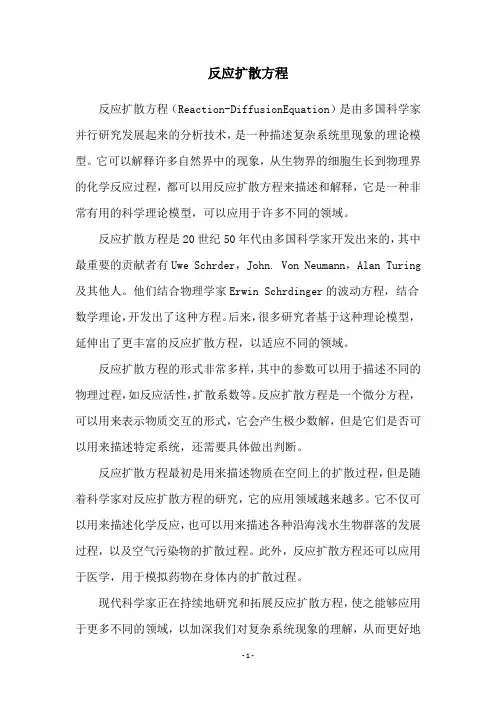
反应扩散方程反应扩散方程(Reaction-DiffusionEquation)是由多国科学家并行研究发展起来的分析技术,是一种描述复杂系统里现象的理论模型。
它可以解释许多自然界中的现象,从生物界的细胞生长到物理界的化学反应过程,都可以用反应扩散方程来描述和解释,它是一种非常有用的科学理论模型,可以应用于许多不同的领域。
反应扩散方程是20世纪50年代由多国科学家开发出来的,其中最重要的贡献者有Uwe Schrder,John. Von Neumann,Alan Turing 及其他人。
他们结合物理学家Erwin Schrdinger的波动方程,结合数学理论,开发出了这种方程。
后来,很多研究者基于这种理论模型,延伸出了更丰富的反应扩散方程,以适应不同的领域。
反应扩散方程的形式非常多样,其中的参数可以用于描述不同的物理过程,如反应活性,扩散系数等。
反应扩散方程是一个微分方程,可以用来表示物质交互的形式,它会产生极少数解,但是它们是否可以用来描述特定系统,还需要具体做出判断。
反应扩散方程最初是用来描述物质在空间上的扩散过程,但是随着科学家对反应扩散方程的研究,它的应用领域越来越多。
它不仅可以用来描述化学反应,也可以用来描述各种沿海浅水生物群落的发展过程,以及空气污染物的扩散过程。
此外,反应扩散方程还可以应用于医学,用于模拟药物在身体内的扩散过程。
现代科学家正在持续地研究和拓展反应扩散方程,使之能够应用于更多不同的领域,以加深我们对复杂系统现象的理解,从而更好地把握自然规律,提高人类的生活质量。
反应扩散方程已经成为当今最重要的理论模型之一,它能够帮助人们更深入地理解复杂系统。
它有助于改善日常生活,并可以帮助我们更好地利用自然资源,从而提高人类的生活质量。
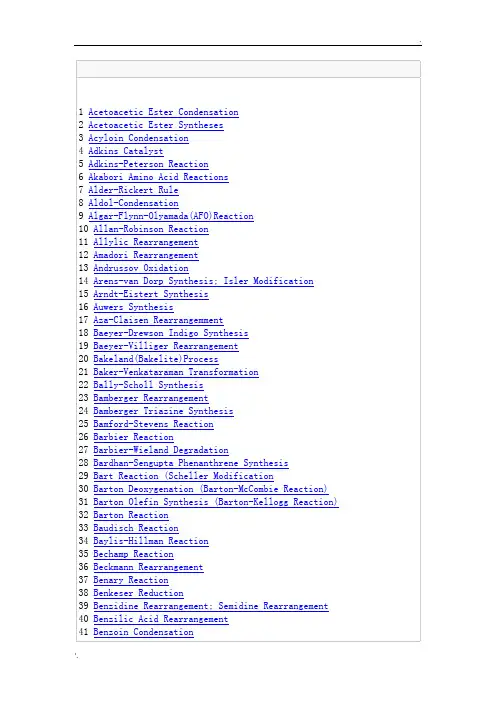
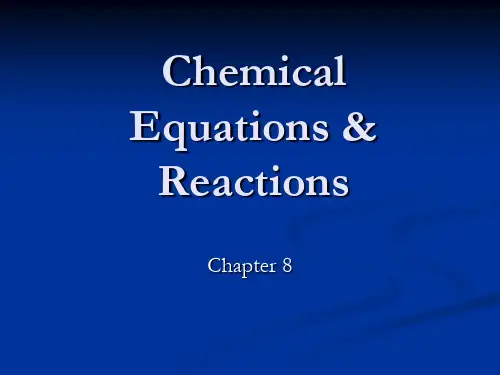
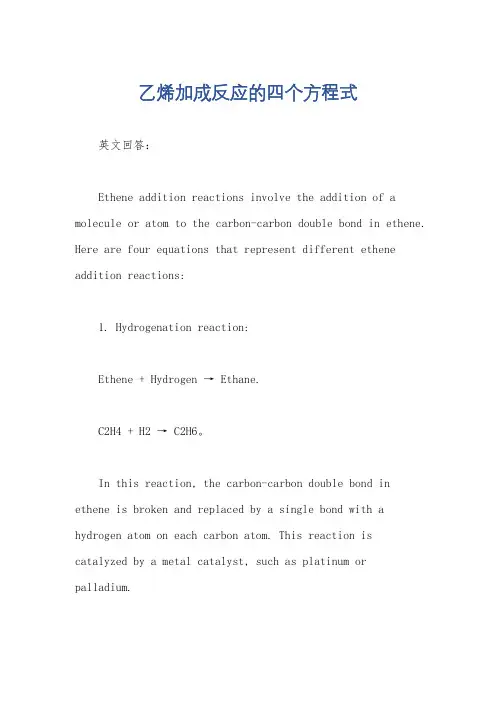
乙烯加成反应的四个方程式英文回答:Ethene addition reactions involve the addition of a molecule or atom to the carbon-carbon double bond in ethene. Here are four equations that represent different ethene addition reactions:1. Hydrogenation reaction:Ethene + Hydrogen → Ethane.C2H4 + H2 → C2H6。
In this reaction, the carbon-carbon double bond in ethene is broken and replaced by a single bond with a hydrogen atom on each carbon atom. This reaction is catalyzed by a metal catalyst, such as platinum or palladium.2. Halogenation reaction:Ethene + Chlorine → 1,2-Dichloroethane.C2H4 + Cl2 → C2H4Cl2。
In this reaction, one chlorine atom is added to each carbon atom of the ethene molecule. The resulting product is a dichloroalkane. This reaction can also be carried out with other halogens, such as bromine or iodine.3. Hydration reaction:Ethene + Water → Ethanol.C2H4 + H2O → C2H5OH.In this reaction, a water molecule adds across the carbon-carbon double bond in ethene, resulting in the formation of an alcohol. This reaction is catalyzed by an acid catalyst, such as sulfuric acid or phosphoric acid.4. Addition of a halogen acid:Ethene + Hydrogen Chloride → Chloroethane.C2H4 + HCl → C2H5Cl.In this reaction, a hydrogen atom from the hydrochloric acid adds to one carbon atom of the ethene molecule, while the chlorine atom adds to the other carbon atom. The resulting product is a haloalkane. This reaction can also be carried out with other halogen acids, such as hydrogen bromide or hydrogen iodide.These four equations represent different types of addition reactions that can occur with ethene. Each reaction has its own conditions and catalysts, resulting in different products. Ethene addition reactions are important in organic chemistry as they allow for the synthesis of a wide range of organic compounds.中文回答:乙烯加成反应涉及将分子或原子加到乙烯的碳-碳双键上。
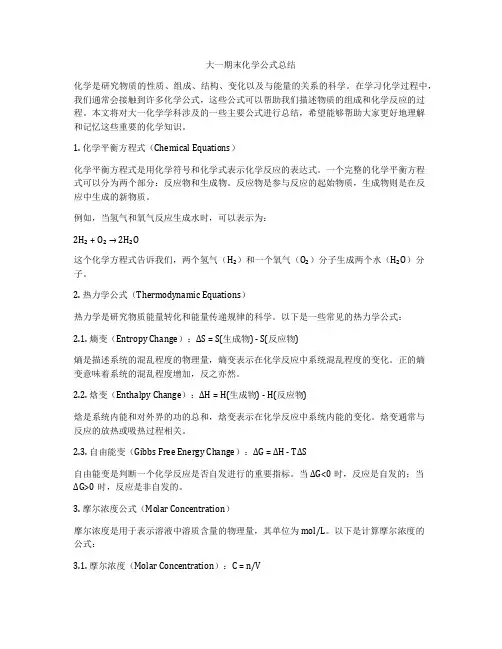
大一期末化学公式总结化学是研究物质的性质、组成、结构、变化以及与能量的关系的科学。
在学习化学过程中,我们通常会接触到许多化学公式,这些公式可以帮助我们描述物质的组成和化学反应的过程。
本文将对大一化学学科涉及的一些主要公式进行总结,希望能够帮助大家更好地理解和记忆这些重要的化学知识。
1. 化学平衡方程式(Chemical Equations)化学平衡方程式是用化学符号和化学式表示化学反应的表达式。
一个完整的化学平衡方程式可以分为两个部分:反应物和生成物。
反应物是参与反应的起始物质,生成物则是在反应中生成的新物质。
例如,当氢气和氧气反应生成水时,可以表示为:2H₂ + O₂ → 2H₂O这个化学方程式告诉我们,两个氢气(H₂)和一个氧气(O₂)分子生成两个水(H₂O)分子。
2. 热力学公式(Thermodynamic Equations)热力学是研究物质能量转化和能量传递规律的科学。
以下是一些常见的热力学公式:2.1. 熵变(Entropy Change):ΔS = S(生成物) - S(反应物)熵是描述系统的混乱程度的物理量,熵变表示在化学反应中系统混乱程度的变化。
正的熵变意味着系统的混乱程度增加,反之亦然。
2.2. 焓变(Enthalpy Change):ΔH = H(生成物) - H(反应物)焓是系统内能和对外界的功的总和,焓变表示在化学反应中系统内能的变化。
焓变通常与反应的放热或吸热过程相关。
2.3. 自由能变(Gibbs Free Energy Change):ΔG = ΔH - TΔS自由能变是判断一个化学反应是否自发进行的重要指标。
当ΔG<0时,反应是自发的;当ΔG>0时,反应是非自发的。
3. 摩尔浓度公式(Molar Concentration)摩尔浓度是用于表示溶液中溶质含量的物理量,其单位为mol/L。
以下是计算摩尔浓度的公式:3.1. 摩尔浓度(Molar Concentration):C = n/V摩尔浓度等于溶质的物质量(以摩尔为单位)与溶液体积的比值。

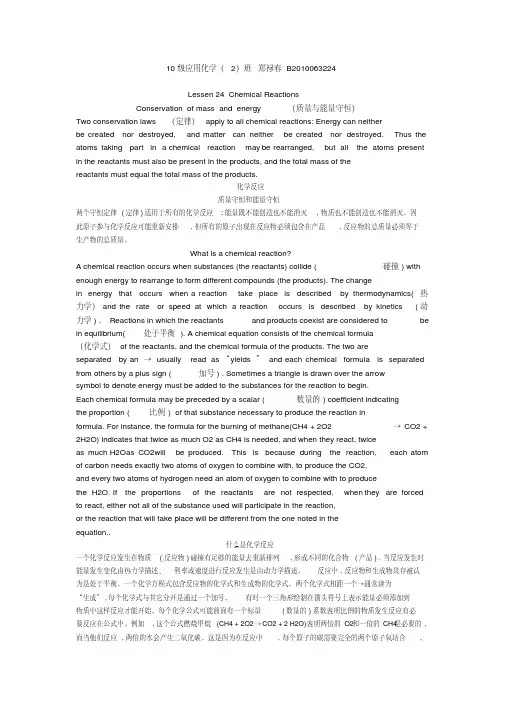
10级应用化学(2)班郑禄春 B2010063224Lessen 24 Chemical ReactionsConservation of mass and energy(质量与能量守恒)Two conservation laws(定律) apply to all chemical reactions: Energy can neitherbe created nor destroyed, and matter can neither be created nor destroyed. Thus the atoms taking part in a chemical reaction may be rearranged, but all the atoms present in the reactants must also be present in the products, and the total mass of thereactants must equal the total mass of the products.化学反应质量守恒和能量守恒两个守恒定律(定律)适用于所有的化学反应:能量既不能创造也不能消灭,物质也不能创造也不能消灭。
因此原子参与化学反应可能重新安排,但所有的原子出现在反应物必须包含在产品,反应物的总质量必须等于生产物的总质量。
What is a chemical reaction?A chemical reaction occurs when substances (the reactants) collide (碰撞) with enough energy to rearrange to form different compounds (the products). The changein energy that occurs when a reaction take place is described by thermodynamics(热力学)and the rate or speed at which a reaction occurs is described by kinetics (动力学) . Reactions in which the reactants and products coexist are considered to be in equilibrium(处于平衡). A chemical equation consists of the chemical formula(化学式)of the reactants, and the chemical formula of the products. The two areseparated by an →usually read as “yields”and each chemical formula is separated from others by a plus sign (加号) . Sometimes a triangle is drawn over the arrowsymbol to denote energy must be added to the substances for the reaction to begin.Each chemical formula may be preceded by a scalar (数量的) coefficient indicatingthe proportion (比例) of that substance necessary to produce the reaction informula. For instance, the formula for the burning of methane(CH4 + 2O2 → CO2 + 2H2O) indicates that twice as much O2 as CH4 is needed, and when they react, twiceas much H2O a s CO2 w ill be produced. This is because during the reaction, each atom of carbon needs exactly two atoms of oxygen to combine with, to produce the CO2,and every two atoms of hydrogen need an atom of oxygen to combine with to producethe H2O. If the proportions of the reactants are not respected, when they are forced to react, either not all of the substance used will participate in the reaction,or the reaction that will take place will be different from the one noted in theequation..什么是化学反应一个化学反应发生在物质(反应物)碰撞有足够的能量去重新排列,形成不同的化合物(产品)。
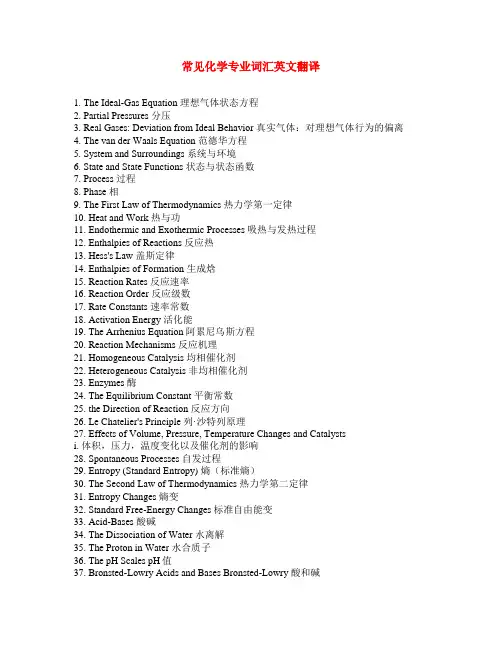
常见化学专业词汇英文翻译1. The Ideal-Gas Equation 理想气体状态方程2. Partial Pressures 分压3. Real Gases: Deviation from Ideal Behavior 真实气体:对理想气体行为的偏离4. The van der Waals Equation 范德华方程5. System and Surroundings 系统与环境6. State and State Functions 状态与状态函数7. Process 过程8. Phase 相9. The First Law of Thermodynamics 热力学第一定律10. Heat and Work 热与功11. Endothermic and Exothermic Processes 吸热与发热过程12. Enthalpies of Reactions 反应热13. Hess's Law 盖斯定律14. Enthalpies of Formation 生成焓15. Reaction Rates 反应速率16. Reaction Order 反应级数17. Rate Constants 速率常数18. Activation Energy 活化能19. The Arrhenius Equation 阿累尼乌斯方程20. Reaction Mechanisms 反应机理21. Homogeneous Catalysis 均相催化剂22. Heterogeneous Catalysis 非均相催化剂23. Enzymes 酶24. The Equilibrium Constant 平衡常数25. the Direction of Reaction 反应方向26. Le Chatelier's Principle 列·沙特列原理27. Effects of Volume, Pressure, Temperature Changes and Catalystsi. 体积,压力,温度变化以及催化剂的影响28. Spontaneous Processes 自发过程29. Entropy (Standard Entropy) 熵(标准熵)30. The Second Law of Thermodynamics 热力学第二定律31. Entropy Changes 熵变32. Standard Free-Energy Changes 标准自由能变33. Acid-Bases 酸碱34. The Dissociation of Water 水离解35. The Proton in Water 水合质子36. The pH Scales pH值37. Bronsted-Lowry Acids and Bases Bronsted-Lowry 酸和碱38. Proton-Transfer Reactions 质子转移反应39. Conjugate Acid-Base Pairs 共轭酸碱对40. Relative Strength of Acids and Bases 酸碱的相对强度41. Lewis Acids and Bases 路易斯酸碱42. Hydrolysis of Metal Ions 金属离子的水解43. Buffer Solutions 缓冲溶液44. The Common-Ion Effects 同离子效应45. Buffer Capacity 缓冲容量46. Formation of Complex Ions 配离子的形成47. Solubility 溶解度48. The Solubility-Product Constant Ksp 溶度积常数49. Precipitation and separation of Ions 离子的沉淀与分离50. Selective Precipitation of Ions 离子的选择沉淀51. Oxidation-Reduction Reactions 氧化还原反应52. Oxidation Number 氧化数53. Balancing Oxidation-Reduction Equations 氧化还原反应方程的配平54. Half-Reaction 半反应55. Galvani Cell 原电池56. Voltaic Cell 伏特电池57. Cell EMF 电池电动势58. Standard Electrode Potentials 标准电极电势59. Oxidizing and Reducing Agents 氧化剂和还原剂60. The Nernst Equation 能斯特方程61. Electrolysis 电解62. The Wave Behavior of Electrons 电子的波动性63. Bohr's Model of The Hydrogen Atom 氢原子的波尔模型64. Line Spectra 线光谱65. Quantum Numbers 量子数66. Electron Spin 电子自旋67. Atomic Orbital 原子轨道68. The s (p, d, f) Orbital s(p,d,f)轨道69. Many-Electron Atoms 多电子原子70. Energies of Orbital 轨道能量71. The Pauli Exclusion Principle 泡林不相容原理72. Electron Configurations 电子构型73. The Periodic Table 周期表74. Row 行75. Group 族76. Isotopes, Atomic Numbers, and Mass Numbers 同位素,原子数,质量数77. Periodic Properties of the Elements 元素的周期律78. Radius of Atoms 原子半径79. Ionization Energy 电离能80. Electronegativity 电负性81. Effective Nuclear Charge 有效核电荷82. Electron Affinities 亲电性83. Metals 金属84. Nonmetals 非金属85. Valence Bond Theory 价键理论86. Covalence Bond 共价键87. Orbital Overlap 轨道重叠88. Multiple Bonds 重键89. Hybrid Orbital 杂化轨道90. The VSEPR Model 价层电子对互斥理论91. Molecular Geometries 分子空间构型92. Molecular Orbital 分子轨道93. Diatomic Molecules 双原子分子94. Bond Length 键长95. Bond Order 键级96. Bond Angles 键角97. Bond Enthalpies 键能98. Bond Polarity 键矩99. Dipole Moments 偶极矩100. Polarity Molecules 极性分子101. Polyatomic Molecules 多原子分子102. Crystal Structure 晶体结构103. Non-Crystal 非晶体104. Close Packing of Spheres 球密堆积105. Metallic Solids 金属晶体106. Metallic Bond 金属键107. Alloys 合金108. Ionic Solids 离子晶体109. Ion-Dipole Forces 离子偶极力110. Molecular Forces 分子间力111. Intermolecular Forces 分子间作用力112. Hydrogen Bonding 氢键113. Covalent-Network Solids 原子晶体114. Compounds 化合物115. The Nomenclature, Composition and Structure of Complexes 配合物的命名,组成和结构116. Charges, Coordination Numbers, and Geometries 电荷数、配位数、及几何构型117. Chelates 螯合物118. Isomerism 异构现象119. Structural Isomerism 结构异构120. Stereoisomerism 立体异构121. Magnetism 磁性122. Electron Configurations in Octahedral Complexes 八面体构型配合物的电子分布123. Tetrahedral and Square-planar Complexes 四面体和平面四边形配合物124. General Characteristics 共性125. s-Block Elements s区元素126. Alkali Metals 碱金属127. Alkaline Earth Metals 碱土金属128. Hydrides 氢化物129. Oxides 氧化物130. Peroxides and Superoxides 过氧化物和超氧化物131. Hydroxides 氢氧化物132. Salts 盐133. p-Block Elements p区元素134. Boron Group (Boron, Aluminium, Gallium, Indium, Thallium) 硼族(硼,铝,镓,铟,铊)135. Borane 硼烷136. Carbon Group (Carbon, Silicon, Germanium, Tin, Lead) 碳族(碳,硅,锗,锡,铅)137. Graphite, Carbon Monoxide, Carbon Dioxide 石墨,一氧化碳,二氧化碳138. Carbonic Acid, Carbonates and Carbides 碳酸,碳酸盐,碳化物139. Occurrence and Preparation of Silicon 硅的存在和制备140. Silicic Acid,Silicates 硅酸,硅酸盐141. Nitrogen Group (Phosphorus, Arsenic, Antimony, and Bismuth) 氮族(磷,砷,锑,铋)142. Ammonia, Nitric Acid, Phosphoric Acid 氨,硝酸,磷酸143. Phosphorates, phosphorus Halides 磷酸盐,卤化磷144. Oxygen Group (Oxygen, Sulfur, Selenium, and Tellurium) 氧族元素(氧,硫,硒,碲)145. Ozone, Hydrogen Peroxide 臭氧,过氧化氢146. Sulfides 硫化物147. Halogens (Fluorine, Chlorine, Bromine, Iodine) 卤素(氟,氯,溴,碘)148. Halides, Chloride 卤化物,氯化物149. The Noble Gases 稀有气体150. Noble-Gas Compounds 稀有气体化合物151. d-Block elements d区元素152. Transition Metals 过渡金属153. Potassium Dichromate 重铬酸钾154. Potassium Permanganate 高锰酸钾155. Iron Copper Zinc Mercury 铁,铜,锌,汞156. f-Block Elements f区元素157. Lanthanides 镧系元素158. Radioactivity 放射性159. Nuclear Chemistry 核化学160. Nuclear Fission 核裂变161. Nuclear Fusion 核聚变162. analytical chemistry 分析化学163. qualitative analysis 定性分析164. quantitative analysis 定量分析165. chemical analysis 化学分析166. instrumental analysis 仪器分析167. titrimetry 滴定分析168. gravimetric analysis 重量分析法169. regent 试剂170. chromatographic analysis 色谱分析171. product 产物172. electrochemical analysis 电化学分析173. on-line analysis 在线分析174. macro analysis 常量分析175. characteristic 表征176. micro analysis 微量分析177. deformation analysis 形态分析178. semimicro analysis 半微量分析179. systematical error 系统误差180. routine analysis 常规分析181. random error 偶然误差182. arbitration analysis 仲裁分析183. gross error 过失误差184. normal distribution 正态分布185. accuracy 准确度186. deviation偏差187. precision 精密度188. relative standard deviation 相对标准偏差(RSD)189. coefficient variation 变异系数(CV)190. confidence level 置信水平191. confidence interval 置信区间192. significant test 显著性检验193. significant figure 有效数字194. standard solution 标准溶液195. titration 滴定196. stoichiometric point 化学计量点197. end point滴定终点198. titration error 滴定误差199. primary standard 基准物质200. amount of substance 物质的量201. standardization 标定202. chemical reaction 化学反应203. concentration浓度204. chemical equilibrium 化学平衡205. titer 滴定度206. general equation for a chemical reaction化学反应的通式207. proton theory of acid-base 酸碱质子理论208. acid-base titration 酸碱滴定法209. dissociation constant 解离常数210. conjugate acid-base pair 共轭酸碱对211. acetic acid 乙酸212. hydronium ion水合氢离子213. electrolyte 电解质214. ion-product constant of water 水的离子积215. ionization 电离216. proton condition 质子平衡217. zero level零水准218. buffer solution缓冲溶液219. methyl orange 甲基橙220. acid-base indicator 酸碱指示剂221. phenolphthalein 酚酞222. coordination compound 配位化合物223. center ion 中心离子224. cumulative stability constant 累积稳定常数225. alpha coefficient 酸效应系数226. overall stability constant 总稳定常数227. ligand 配位体228. ethylenediamine tetraacetic acid 乙二胺四乙酸229. side reaction coefficient 副反应系数230. coordination atom 配位原子231. coordination number 配位数232. lone pair electron 孤对电子233. chelate compound 螯合物234. metal indicator 金属指示剂235. chelating agent 螯合剂236. masking 掩蔽237. demasking 解蔽238. electron 电子239. catalysis 催化240. oxidation氧化241. catalyst 催化剂242. reduction 还原243. catalytic reaction 催化反应244. reaction rate 反应速率245. electrode potential 电极电势246. activation energy 反应的活化能247. redox couple 氧化还原电对248. potassium permanganate 高锰酸钾249. iodimetry碘量法250. potassium dichromate 重铬酸钾251. cerimetry 铈量法252. redox indicator 氧化还原指示253. oxygen consuming 耗氧量(OC)254. chemical oxygen demanded 化学需氧量(COD) 255. dissolved oxygen 溶解氧(DO)256. precipitation 沉淀反应257. argentimetry 银量法258. heterogeneous equilibrium of ions 多相离子平衡259. aging 陈化260. postprecipitation 继沉淀261. coprecipitation 共沉淀262. ignition 灼烧263. fitration 过滤264. decantation 倾泻法265. chemical factor 化学因数266. spectrophotometry 分光光度法267. colorimetry 比色分析268. transmittance 透光率269. absorptivity 吸光率270. calibration curve 校正曲线271. standard curve 标准曲线272. monochromator 单色器273. source 光源274. wavelength dispersion 色散275. absorption cell吸收池276. detector 检测系统277. bathochromic shift 红移278. Molar absorptivity 摩尔吸光系数279. hypochromic shift 紫移280. acetylene 乙炔281. ethylene 乙烯282. acetylating agent 乙酰化剂283. acetic acid 乙酸284. adiethyl ether 乙醚285. ethyl alcohol 乙醇286. acetaldehtde 乙醛287. β-dicarbontl compound β-二羰基化合物288. bimolecular elimination 双分子消除反应289. bimolecular nucleophilic substitution 双分子亲核取代反应290. open chain compound 开链族化合物291. molecular orbital theory 分子轨道理论292. chiral molecule 手性分子293. tautomerism 互变异构现象294. reaction mechanism 反应历程295. chemical shift 化学位移296. Walden inversio 瓦尔登反转n297. Enantiomorph 对映体298. addition rea ction 加成反应299. dextro- 右旋300. levo- 左旋301. stereochemistry 立体化学302. stereo isomer 立体异构体303. Lucas reagent 卢卡斯试剂304. covalent bond 共价键305. conjugated diene 共轭二烯烃306. conjugated double bond 共轭双键307. conjugated system 共轭体系308. conjugated effect 共轭效应309. isomer 同分异构体310. isomerism 同分异构现象311. organic chemistry 有机化学312. hybridization 杂化313. hybrid orbital 杂化轨道314. heterocyclic compound 杂环化合物315. peroxide effect 过氧化物效应t316. valence bond theory 价键理论317. sequence rule 次序规则318. electron-attracting grou p 吸电子基319. Huckel rule 休克尔规则320. Hinsberg test 兴斯堡试验321. infrared spectrum 红外光谱322. Michael reacton 麦克尔反应323. halogenated hydrocarbon 卤代烃324. haloform reaction 卤仿反应325. systematic nomenclatur 系统命名法e326. Newman projection 纽曼投影式327. aromatic compound 芳香族化合物328. aromatic character 芳香性r329. Claisen condensation reaction克莱森酯缩合反应330. Claisen rearrangement 克莱森重排331. Diels-Alder reation 狄尔斯-阿尔得反应332. Clemmensen reduction 克莱门森还原333. Cannizzaro reaction 坎尼扎罗反应334. positional isomers 位置异构体335. unimolecular elimination reaction 单分子消除反应336. unimolecular nucleophilic substitution 单分子亲核取代反应337. benzene 苯338. functional grou 官能团p339. configuration 构型340. conformation 构象341. confomational isome 构象异构体342. electrophilic addition 亲电加成343. electrophilic reagent 亲电试剂344. nucleophilic addition 亲核加成345. nucleophilic reagent 亲核试剂346. nucleophilic substitution reaction亲核取代反应347. active intermediate 活性中间体348. Saytzeff rule 查依采夫规则349. cis-trans isomerism 顺反异构350. inductive effect 诱导效应 t351. Fehling's reagent 费林试剂352. phase transfer catalysis 相转移催化作用353. aliphatic compound 脂肪族化合物354. elimination reaction 消除反应355. Grignard reagent 格利雅试剂356. nuclear magnetic resonance 核磁共振357. alkene 烯烃358. allyl cation 烯丙基正离子359. leaving group 离去基团360. optical activity 旋光性361. boat confomation 船型构象362. silver mirror reaction 银镜反应363. Fischer projection 菲舍尔投影式364. Kekule structure 凯库勒结构式365. Friedel-Crafts reaction 傅列德尔-克拉夫茨反应366. Ketone 酮367. carboxylic acid 羧酸368. carboxylic acid derivative 羧酸衍生物369. hydroboration 硼氢化反应370. bond oength 键长371. bond energy 键能372. bond angle 键角373. carbohydrate 碳水化合物374. carbocation 碳正离子375. carbanion 碳负离子376. alcohol 醇377. Gofmann rule 霍夫曼规则378. Aldehyde 醛379. Ether 醚380. Polymer 聚合物相对原子质量 relative atomic mass消去反应 elimination reaction硝化反应 nitratlon reaction硝酸钡 barium nitrate硝酸银 silver nitrate溴的四氯化碳溶液 solution of bromine in carbon tetrachloride 溴化钠 sodium bromide溴水 bromine water溴水 bromine water盐类的水解 hydrolysis of salts盐析 salting-out焰色反应 flame test氧化剂 oxidizing agent氧化铝 aluminium oxide氧化铁 iron (III) oxide乙醇 ethanol乙醛 ethana1乙炔 ethyne乙酸 ethanoic acid乙酸乙酯 ethyl acetate乙烯 ethene银镜反应 silver mirror reaction硬脂酸 stearic acid油脂 oils and fats有机化合物 organic compound元素周期表 periodic table of elements元素周期律 periodic law of elements原电池 primary battery原子序数 atomic number皂化反应 saponification粘合剂 adhesive蔗糖 sucrose指示剂 Indicator酯 ester酯化反应 esterification周期 period族 group(主族:main group)Bunsen burner 本生灯product 化学反应产物flask 烧瓶apparatus 设备PH indicator PH值指示剂,氢离子(浓度的)负指数指示剂 matrass 卵形瓶litmus 石蕊litmus paper 石蕊试纸graduate, graduated flask 量筒,量杯reagent 试剂test tube 试管burette 滴定管retort 曲颈甑still 蒸馏釜cupel 烤钵crucible pot, melting pot 坩埚pipette 吸液管filter 滤管stirring rod 搅拌棒element 元素body 物体compound 化合物atom 原子gram atom 克原子atomic weight 原子量atomic number 原子数atomic mass 原子质量molecule 分子electrolyte 电解质ion 离子anion 阴离子cation 阳离子electron 电子isotope 同位素isomer 同分异物现象polymer 聚合物symbol 复合radical 基structural formula 分子式valence, valency 价monovalent 单价bivalent 二价halogen 成盐元素bond 原子的聚合mixture 混合combination 合成作用compound 合成物alloy 合金organic chemistry 有机化学inorganic chemistry 无机化学derivative 衍生物series 系列acid 酸hydrochloric acid 盐酸sulphuric acid 硫酸nitric acid 硝酸aqua fortis 王水fatty acid 脂肪酸organic acid 有机酸 hydrosulphuric acid 氢硫酸 hydrogen sulfide 氢化硫alkali 碱,强碱ammonia 氨base 碱hydrate 水合物hydroxide 氢氧化物,羟化物hydracid 氢酸hydrocarbon 碳氢化合物,羟anhydride 酐alkaloid 生物碱aldehyde 醛oxide 氧化物phosphate 磷酸盐acetate 醋酸盐methane 甲烷,沼气butane 丁烷salt 盐potassium carbonate 碳酸钾soda 苏打sodium carbonate 碳酸钠caustic potash 苛性钾caustic soda 苛性钠ester 酯gel 凝胶体analysis 分解fractionation 分馏endothermic reaction 吸热反应exothermic reaction 放热反应precipitation 沉淀to precipitate 沉淀to distil, to distill 蒸馏distillation 蒸馏to calcine 煅烧to oxidize 氧化alkalinization 碱化to oxygenate, to oxidize 脱氧,氧化 to neutralize 中和to hydrogenate 氢化to hydrate 水合,水化to dehydrate 脱水fermentation 发酵solution 溶解combustion 燃烧fusion, melting 熔解alkalinity 碱性isomerism, isomery 同分异物现象 hydrolysis 水解electrolysis 电解electrode 电极anode 阳极,正极cathode 阴极,负极catalyst 催化剂catalysis 催化作用oxidization, oxidation 氧化reducer 还原剂dissolution 分解synthesis 合成reversible 可逆的摩尔 mole摩尔质量 molar mass品红 magenta或fuchsine葡萄糖 glucose气体摩尔体积 molar volume of gas铅蓄电池 lead storage battery强电解质 strong electrolyte氢氟酸 hydrogen chloride氢氧化铝 aluminium hydroxide取代反应 substitution reaction醛 aldehyde炔烃 alkyne燃料电池 fuel cell弱电解质 weak electrolyte石油 Petroleum水解反应 hydrolysis reaction四氯化碳 carbon tetrachloride塑料 plastic塑料的降解 plastic degradation塑料的老化 plastic ageing酸碱中和滴定 acid-base neutralization titration 酸雨 acid rain羧酸 carboxylic acid碳酸钠 sodium carbonate碳酸氢铵 ammonium bicarbonate碳酸氢钠 sodium bicarbonate糖类 carbohydrate烃 hydrocarbon烃的衍生物 derivative of hydrocarbon烃基 hydrocarbonyl同分异构体 isomer同素异形体 allotrope同位素 isotope同系物 homo1og涂料 coating烷烃 alkane物质的量 amount of substance物质的量浓度 amount-of-substance concentration of B 烯烃 alkene洗涤剂 detergent纤维素 cellulose相对分子质量 relative molecular mass极性键 polar bond加成反应 addition reaction加聚反应 addition polymerization甲烷 methane碱金属 alkali metal碱石灰 soda lime结构式 structural formula聚合反应 po1ymerization可逆反应 reversible reaction空气污染指数 air pollution index勒夏特列原理 Le Chatelier's principle离子反应 ionic reaction离子方程式 ionic equation离子键 ionic bond锂电池 lithium cell两性氢氧化物 amphoteric hydroxide两性氧化物 amphoteric oxide裂化 cracking裂解 pyrolysis硫氰化钾 potassium thiocyanate硫酸钠 sodium sulphide氯化铵 ammonium chloride氯化钡 barium chloride氯化钾 potassium chloride氯化铝 aluminium chloride氯化镁 magnesium chloride氯化氢 hydrogen chloride氯化铁 iron (III) chloride氯水 chlorine water麦芽糖 maltose煤 coal酶 enzyme二氧化氮 nitrogen dioxide二氧化硅 silicon dioxide二氧化硫 sulphur dioxide二氧化锰 manganese dioxide芳香烃 arene放热反应 exothermic reaction非极性分子 non-polar molecule非极性键 non-polar bond肥皂 soap分馏 fractional distillation酚 phenol复合材料 composite干电池 dry cell干馏 dry distillation甘油 glycerol高分子化合物 polymer共价键 covalent bond官能团 functional group光化学烟雾 photochemical fog过氧化氢 hydrogen peroxide合成材料 synthetic material合成纤维 synthetic fiber合成橡胶 synthetic rubber核电荷数 nuclear charge number核素 nuclide化学电源 chemical power source化学反应速率 chemical reaction rate 化学键 chemical bond化学平衡 chemical equilibrium还原剂 reducing agent磺化反应 sulfonation reaction霍尔槽 Hull Cell极性分子 polar moleculeActinium(Ac) 锕Aluminium(Al) 铝Americium(Am) 镅Antimony(Sb) 锑Argon(Ar) 氩Arsenic(As) 砷Astatine(At) 砹Barium(Ba) 钡Berkelium(Bk) 锫 Beryllium(Be) 铍 Bismuth(Bi) 铋Boron(B) 硼Bromine(Br) 溴Cadmium(Cd) 镉 Caesium(Cs) 铯Calcium(Ca) 钙Californium(Cf) 锎 Carbon(C) 碳Cerium(Ce) 铈Chlorine(Cl) 氯Chromium(Cr) 铬 Cobalt(Co) 钴Copper(Cu) 铜Curium(Cm) 锔Dysprosium(Dy) 镝 Einsteinium(Es) 锿 Erbium(Er) 铒Europium(Eu) 铕 Fermium(Fm) 镄 Fluorine(F) 氟Francium(Fr) 钫Gadolinium(Gd) 钆 Gallium(Ga) 镓Germanium(Ge) 锗 Gold(Au) 金Hafnium(Hf) 铪Helium(He) 氦Holmium(Ho) 钬 Hydrogen(H) 氢Indium(In) 铟Iodine(I) 碘Iridium(Ir) 铱Iron(Fe) 铁Krypton(Kr) 氪Lanthanum(La) 镧 Lawrencium(Lr) 铹Lead(Pb) 铅Lithium(Li) 锂Lutetium(Lu) 镥Magnesium(Mg) 镁Manganese(Mn) 锰Mendelevium(Md) 钔 Mercury(Hg) 汞 Molybdenum(Mo) 钼Neodymium(Nd) 钕Neon(Ne) 氖Neptunium(Np) 镎Nickel(Ni) 镍Niobium(Nb) 铌Nitrogen(N) 氮Nobelium(No) 锘Osmium(Os) 锇Oxygen(O) 氧Palladium(Pd) 钯Phosphorus(P) 磷Platinum(Pt) 铂Plutonium(Pu) 钚Polonium(Po) 钋Potassium(K) 钾Praseodymium(Pr) 镨Promethium(Pm) 钷Protactinium(Pa) 镤Radium(Ra) 镭Radon(Rn) 氡Rhenium(Re) 铼Rhodium(Rh) 铑Rubidium(Rb) 铷Ruthenium(Ru) 钌Samarium(Sm) 钐Scandium(Sc) 钪Selenium(Se) 硒Silicon(Si) 硅Silver(Ag) 银Sodium(Na) 钠Strontium(Sr) 锶Sulphur(S) 锍Tantalum(Ta) 钽Technetium(Tc) 锝Tellurium(Te) 碲Terbium(Tb) 铽Thallium(Tl) 铊Thorium(Th) 钍Tin(Sn) 锡Thulium(Tm) 铥Titanium(Ti) 钛Tungsten(W) 钨Uranium(U) 铀Vanadium(V) 钒Xenon(Xe) 氙Ytterbium(Yb) 镱Yttrium(Y) 钇Zinc(Zn) 锌Zirconium(Zr) 锆●化学常用词汇汉英对照表1●氨 ammonia氨基酸 amino acid铵盐 ammonium salt饱和链烃 saturated aliphatic hydrocarbon苯 benzene变性 denaturation不饱和烃 unsaturated hydrocarbon超导材料 superconductive material臭氧 ozone醇 alcohol次氯酸钾 potassium hypochlorite醋酸钠 sodium acetate蛋白质 protein氮族元素 nitrogen group element碘化钾 potassium iodide碘化钠 sodium iodide电化学腐蚀 electrochemical corrosion电解质 electrolyte电离平衡 ionization equilibrium电子云 electron cloud淀粉 starch淀粉碘化钾试纸 starch potassium iodide paper。
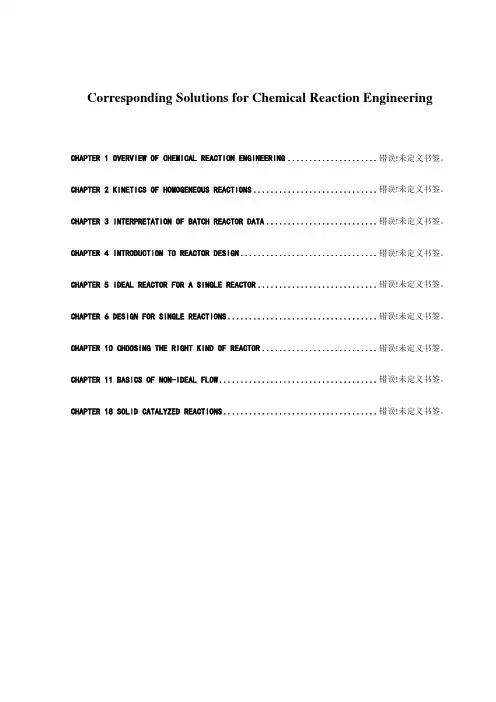
Corresponding Solutions for Chemical Reaction EngineeringCHAPTER 1 OVERVIEW OF CHEMICAL REACTION ENGINEERING ..................... 错误!未定义书签。
CHAPTER 2 KINETICS OF HOMOGENEOUS REACTIONS ............................. 错误!未定义书签。
CHAPTER 3 INTERPRETATION OF BATCH REACTOR DATA .......................... 错误!未定义书签。
CHAPTER 4 INTRODUCTION TO REACTOR DESIGN ................................ 错误!未定义书签。
CHAPTER 5 IDEAL REACTOR FOR A SINGLE REACTOR ............................ 错误!未定义书签。
CHAPTER 6 DESIGN FOR SINGLE REACTIONS ................................... 错误!未定义书签。
CHAPTER 10 CHOOSING THE RIGHT KIND OF REACTOR ........................... 错误!未定义书签。
CHAPTER 11 BASICS OF NON-IDEAL FLOW ..................................... 错误!未定义书签。
CHAPTER 18 SOLID CATALYZED REACTIONS .................................... 错误!未定义书签。
Chapter 1 Overview of Chemical Reaction Engineering1.1 Municipal waste water treatment plant. Consider a municipal water treatment plant for a small community Waste water, 32000 m 3/day, flows through the treatment plant with a mean residence time of 8 hr, air is bubbled through the tanks, and microbes in the tank attack and break down the organic material (organic waste) +O 2 −−−→−microbes CO 2 + H 2OA typical entering feed has a BOD (biological oxygen demand) of 200 mg O 2/liter, while the effluent has a megligible BOD. Find the rate of reaction, or decrease in BOD in the treatment tanks.FigureSolution:)/(1017.2)/(75.183132/100010001)0200()(313200031320001343333s m mol day m mol day molgm L mg g L mg day day m dayday m VdtdN r AA ⋅⨯=⋅=-⨯⨯⨯-⨯-=-=--1.2 Coal burning electrical power station. Large central power stations (about 1000 MW electrical) using fluiding bed combustors may be built some day (see These giants would be fed 240 tons of coal/hr (90% C, 10%H 2), 50% of whichWaste water3Clean water3200 mg O 2Zero O 2would burn within the battery of primary fluidized beds, the other 50% elsewhere in the system. One suggested design would use a battery of 10 fluidized beds, each 20 m long, 4 m wide, and containing solids to a depth of 1 m. Find the rate of reaction within the beds, based on the oxygen used.Solution:380010)1420(m V =⨯⨯⨯=)/(9000101089.05.01024033hr bed molc hrkgckgcoal kgc hr coal t N c ⋅-=⨯-=⨯⨯⨯-=∆∆ )/(25.111900080011322hr m kmolO t N V r r c c O ⋅=-⨯-=∆∆-=-=)/(12000412000190002hr bed mol dt dO ⋅=+⨯= )/(17.4800)/(105.113422s m mol hr bed mol dt dO V r O ⋅=⋅⨯==-Chapter 2 Kinetics of Homogeneous ReactionsA reaction has the stoichiometric equation A +B =2R . What is the order of reactionSolution: Because we don’t know whether it is an elementary reaction or not, we can’t tell the index of th e reaction.2.2 Given the reaction 2NO 2 + 1/2 O 2 = N 2O 5 , what is the relation between therates of formation and disappearance of the three reaction components Solution: 522224O N O NO r r r =-=-2.3 A reaction with stoichiometric equation A + B = R + S has the followingrate expression-r A = 2 AC BWhat is the rate expression for this reaction if the stoichiometric equation is written asA + 2B = 2R + SSolution: No change. The stoichiometric equation can’t effect the rate equation, so it doesn’t chang e.For the enzyme-substrate reaction of Example 2, the rate of disappearance ofsubstrate is given by-r A =A06]][[1760C E A + , mol/m 3·sWhat are the units of the two constants Solution: ][]6[]][][[][03A A C E A k s m mol r +=⋅=-3/][]6[m mol C A ==∴sm mol m mol m mol s m mol k 1)/)(/(/][3333=⋅⋅=2.5 For the complex reaction with stoichiometry A + 3B → 2R + S and with second-order rate expression-r A = k 1[A][B]are the reaction rates related as follows: r A = r B = r R If the rates are notso related, then how are they related Please account for the sings , + or - .Solution: R B A r r r 2131=-=-A certain reaction has a rate given by-r A = C2 A , mol/cm 3·minIf the concentration is to be expressed in mol/liter and time in hours,what would be the value and units of the rate constant Solution:min)()(3'⋅⨯-=⋅⨯-cm molr hr L mol r A A 22443'300005.0106610)(minAA A A A C C r r cm mol mol hr L r =⨯⨯=⋅⨯=-⋅⋅⋅=-∴ AA A A A C C cmmol mol L C cmmolC L mol C 33'3'10)()(=⋅⋅=∴⨯=⨯2'42'32'103)10(300300)(AA A A C C C r --⨯=⨯==-∴ 4'103-⨯=∴kFor a gas reaction at 400 K the rate is reported as-dtdp A= p2 A, atm/hr (a) What are the units of the rate constant(b) What is the value of the rate constant for this reaction if the rateequation is expressed as-r A = - dtdN V A1 = k C2 A , mol/m 3·sSolution:(a)The unit of the rate constant is ]/1[hr atm ⋅ (b)dtdN V r AA 1-=-Because it’s a gas reaction occuring at the fined terperatuse, so V=constant, and T=constant, so the equation can be reduced to22)(66.366.3)(1RT C RTP RT dt dP RT dt dP VRT V r A A A A A ==-=-=-22)66.3(A A kC C RT ==So we can get that the value of1.12040008205.066.366.3=⨯⨯==RT kThe pyrolysis of ethane proceeds with an activation energy of about 300 kJ/mol.How much faster the decomposition at 650℃ than at 500℃ Solution:586.7)92311731()10/(314.8/300)11(3211212=-⋅⋅=-==KK K mol kJ mol kJ T T R E k k Ln r r Ln7.197012=∴r rIn the mid-nineteenth century the entomologist Henri Fabre noted that Frenchants (garden variety) busily bustled about their business on hot days but were rather sluggish on cool days. Checking his results with Oregon ants, I findRunning speed, m/hr150160230295370Temperature, ℃1316222428What activation energy represents this change in bustliness Solution:RTE RTE RTE ek eak t cons ion concentrat f let ion concentrat f ek r ---=⋅⋅=⋅='00tan )()(RET Lnk Lnr A 1'-=∴ Suppose Tx Lnr y A 1,==, so ,REslope -= intercept 'Lnk =)/(1-⋅h m r A150 160 230 295 370 A LnrC T o /13 16 22 24 28 3101-⨯T-y = x +Also K REslope 9.5147-=-=, intercept 'Lnk == , mol kJ K mol J K E /80.42)/(3145.89.5147=⋅⨯-=Chapter 3 Interpretation of Batch Reactor DataIf -r A = - (dC A /dt) = mol/liter·sec when C A = 1 mol/liter, what is the rateof reaction when C A = 10 mol/liter Note: the order of reaction is not known.Solution: I nformation is not enough, so we can’t answer this kind of question.3.2 Liquid a sedomposes by first-order kinetics, and in a batch reactor 50%of A is converted in a 5-minute run. How much longer would it take to reach 75% conversionSolution: Because the decomposition of A is a 1st -order reaction, so we can express the rate equation as:A A kC r =-We know that for 1st -order reaction, kt C C LnAAo=, 11kt C C LnA Ao =, 22kt C CLn A Ao = Ao A C C 5.01=, Ao A C C 25.02=So 21)24(1)(11212Ln kLn Ln k C C Ln C C Ln k t t A Ao A Ao =-=-=- equ(1) min 521)(111===Ln kC C Ln k t A Ao equ(2) So m in 5112==-t t t3.3 Repeat the previous problem for second-order kinetics. Solution: We know that for 2nd -order reaction,kt C C A A =-011,So we have two equations as follow:min 511211101k kt C C C C C AoAo Ao A A ===-=-, equ(1) 2123)1(31411kt kt C C C C C AoAo Ao Ao A ===-=-, equ(2) So m in 15312==t t , m in 1012=-t tA 10-minute experimental run shows that 75% of liquid reactant is converted to product by a 21-order rate. What would be the fraction converted in a half-hour run Solution: In a-21order reaction: 5.0AA A kC dt dC r =-=-, After integration, we can get:5.015.02A Ao C C kt -=, So we have two equations as follow:min)10(5.0)41(15.05.05.05.015.0k kt C C C C C Ao Ao AoA Ao ===-=-, equ(1) min)30(25.025.0k kt C C A Ao ==-, equ(2)Combining these two equations, we can get:25.05.1kt C Ao =, but this means 05.02<A C ,which is impossible, so we can conclude that less than half hours, all the reactant is consumed up. So the fraction converted 1=A X .In a hmogeneous isothermal liquid polymerization, 20% of the monomer disappears in 34 minutes for initial monomer concentration of and also for mol/liter. What rate equation represents the disappearance of the monomer Solution: The rate of reactant is independent of the initial concentration of monomers, so we know the order of reaction is first-order,monomer monomer kC r =-And k C C Lnoomin)34(8.0= 1min 00657.0-=kmonomer monomer C r )min 00657.0(1-=-After 8 minutes in a batch reactor, reactant (C A0 = 1 mol/liter) is 80% converted; after 18 minutes, conversion is 90%. Find a rate equation to represent this reaction. Solution:In 1st order reaction, 43.1511111111212==--=Ln Ln X Lnk X Ln k t t A A , dissatisfied.In 2nd order reaction, 49/4/912.0111.01)11(1)11(11212==--=--=Ao Ao Ao Ao Ao Ao Ao A Ao A C C C C C C C C k C C k t t, satisfied.According to the information, the reaction is a 2nd -order reaction.nake-Eyes Magoo is a man of habit. For instance, his Friday evenings are all alike —into the joint with his week’s salary of $180, steady gambling at “2-up” for two hours, then home to his family leaving $45 behind. Snake Eyes’s betting pattern is predictable. He always bets in amounts proportional to his cash at hand, and his losses are also predictable —at a rate proportional to his cash at hand. This week Snake-Eyes received a raise in salary, so he played for three hours, but as usual went home with $135. How much was his raise Solution:180=Ao n , 13=A n , h t 2=,135'=A n , h t 3;=, A A kn r α-So we obtain kt n n LnAAo=, ''')()(tn n Ln t n n Ln AAo A Ao= 3135213180'Ao n Ln Ln =, 28'=AnThe first-order reversible liquid reaction A ↔ R , C A0 = mol/liter, C R0=0takes place in a batch reactor. After 8 minutes, conversion of A is % while equilibrium conversion is %. Find the equation for the this reaction. Solution: Liquid reaction, which belongs to constant volume system, 1st order reversible reaction, according to page56 eq. 53b, we obtain121112102110)(1)(-+-+=+-==⎰⎰AX A A tX k k k k Lnk k X k k k dX dt t Amin 8sec 480==t Θ, 33.0=A X , so we obtain eq(1)33.0)(1min8sec 480211121k k k k Ln k k +-+= eq(1) Ae AeAe c X X M C C k k K -+===1Re 21, 0==AoRo C C M , so we obtain eq(2) 232132121=-=-==AeAe c X X k k K ,212k k =∴ eq(2)Combining eq(1) and eq(2), we obtain1412sec 108.4m in 02888.0---⨯==k 14121sec 1063.9m in 05776.02---⨯===k kSo the rate equation is )(21A Ao A AA C C k C k dtdC r --=-=- )(sec 1063.9sec 108.401414A A A C C C -⨯-⨯=----Aqueous A reacts to form R (A→R) and in the first minute in a batch reactorits concentration drops from C A0 = mol/liter to C Af = mol/liter. Find the rate equation from the reaction if the kinetics are second-order with respect to A.Solution: It’s a irreversible second -order reaction system, according to page44 eq 12, we obtainmin 103.2197.111⋅=-k , so min015.01⋅=mol Lkso the rate equation is 21)min 015.0(A A C r -=-At room temperature sucrose is hydrolyzed by the catalytic action of the enzymesucrase as follows:Aucrose −−→−sucraseproductsStarting with a sucrose concentration C A0 = millimol/liter and an enzymeconcentration C E0= millimol/liter, the following kinetic data are obtained in a batch reactor (concentrations calculated from optical rotation measurements):Determine whether these data can be reasonably fitted by a knietic equationC A ,millimol/lite rt,hr1234567891011of the Michaelis-Menten type, or -r A =MA E A C C C C k +03 where C M = Michaelis constantIf the fit is reasonable, evaluate the constants k 3 and C M . Solve by the integral method.Solution: Solve the question by the integral method:AA M A A Eo A A C k Ck C C C C k dt dC r 5431+=+=-=-, M Eo C C k k 34=, MC k 15= AAo A AoA Ao C C C C Ln k k k C C t -⋅+=-4451hr t ,A C ,mmol/LA Ao AAo C C C C Ln-AAo C C t-1 2 3 4 5 6 7 8 9 10 11Suppose y=A Ao C C t-, x=AAo A Ao C C C C Ln-, thus we obtain such straight line graph9879.0134===Eo M C k C k Slope , intercept=0497.545=k k So )/(1956.00497.59879.015L mmol k C M ===, 14380.1901.09879.01956.0-=⨯==hr C C k k Eo MEnzyme E catalyzes the transformation of reactant A to product R as follows:A −−→−enzymeR, -r A = min22000⋅+liter molC C C A E AIf we introduce enzyme (C E0 = mol/liter) and reactant (C A0 = 10mol/liter) into a batch rector and let the reaction proceed, find the time needed for the concentration of reactant to drop to mol/liter. Note that the concentration of enzyme remains unchanged during the reaction.. Solution:510001.020021+=⨯+=-=-AA A A A C C C dC dt r Rearranging and integrating, we obtain:10025.0025.010)(510)510(⎥⎦⎤⎢⎣⎡-+=+-==⎰⎰A Ao A Ao A A t C C C C Ln dC C dt t min 79.109)(5025.01010=-+=A Ao C C Lnand . Jungers, Bull. soc. chim. France, 386(1957), present the data in Table on thereaction of sulfuric acid with diethylsulfate in a aqueous solutionat ℃:H 2SO 4 + (C 2H 5)2SO 4 → 2C 2H 5SO 4HInitial concentrations of H 2SO 4 and (C 2H 5)2SO 4 are each mol/liter. Find a rate equation for this reaction.Tablet, minC 2H 5SO 4H,mol/litert, minC 2H 5SO 4H,mol/liter0 0 180 41 194 48 212 55 267 75 318 96 368 127 379 146 410 162∞ Solution: It’s a constant -volume system, so we can use X A solving the problem: i) We postulate it is a 2nd order reversible reaction system R B A 2⇔+ The rate equation is: 221R B A A A C k C C k dtdC r -=-=- L mol C C Bo Ao /5.5==, )1(A Ao A X C C -=,A A Ao BoBC X C C C =-=, A Ao R X C C 2=When ∞=t , L mol X C C Ae Ao /8.52Re == So 5273.05.528.5=⨯=Ae X , L mol X C C C Ae Ao Be Ae /6.2)5273.01(5.5)1(=-⨯=-== After integrating, we obtaint C X k X X X X X LnAo AeA Ae A Ae Ae )11(2)12(1-=--- eq (1)The calculating result is presented in following Table.t ,min L mol C R /,L mol C A /,A XA Ae A Ae Ae X X X X X Ln---)12( )1(AeA X XLn -0 0 0 0 0 41 48 55 75 96 127 146 162 180 194 212 267 318 368 379410 ∞——Draw AAe AAe Ae X X X X X Ln---)12(~ t plot, we obtain a straight line:0067.0)11(21=-=Ao AeC X k Slope , min)/(10794.65.5)15273.01(20067.041⋅⨯=⨯-=∴-mol L kWhen approach to equilibrium, BeAe c C C C k k K 2Re 21==, so min)/(10364.18.56.210794.642242Re 12⋅⨯=⨯⨯==--mol L C C C k k Be Ae So the rate equation ism in)/()10364.110794.6(244⋅⨯-⨯=---L mol C C C r R B A Aii) We postulate it is a 1st order reversible reaction system, so the rate equation isR A AA C k C k dtdC r 21-=-=- After rearranging and integrating, we obtaint k X X X Ln AeAe A '11)1(=-eq (2) Draw )1(AeAX X Ln -~ t plot, we obtain another straight line:0068.0'1-==AeX k Slope ,So 13'1m in 10586.35273.00068.0--⨯-=⨯-=k133Re '1'2min 10607.18.56.210586.3---⨯-=⨯⨯-==C C k k AeSo the rate equation ism in)/()10607.110586.3(33⋅⨯+⨯-=---L mol C C r R A AWe find that this reaction corresponds to both a 1st and 2nd order reversible reaction system, by comparing eq.(1) and eq.(2), especially when X Ae = , the two equations are identical. This means these two equations would have almost the same fitness of data when the experiment data of the reaction show that X Ae =.(The data that we use just have X Ae = approached to , so it causes to this.)In the presence of a homogeneous catalyst of given concentration, aqueous reactant A is converted to product at the following rates, and C A alone determinesthis rate:C A ,mol/liter 1 2 4 6 7 9 12 -r A , mol/liter·hrWe plan to run this reaction in a batch reactor at the same catelyst concentration as used in getting the above data. Find the time needed to lower the concentration of A from C A0 = 10 mol/liter to C Af = 2 mol/liter.Solution: By using graphical integration method, we obtain that the shaped area is 50 hr.The thermal decomposition of hydrogen iodide 2HI → H 2 + I 2 is reported by [ as follows:T,℃ 508 427 393 356 283 k,cm 3/mol ·s×10-6×10-6Find the complete rate equation for this reaction. Use units of joules, moles, cm 3, and seconds. According to Arrhenius’ Law,k = k 0e -E/R Ttransform it,0 4 8 1216 20 02468101214Ca-1/Ra- In(k) = E/R·(1/T) -In(k)Drawing the figure of the relationship between k and T as follows:From the figure, we getslope = E/R = intercept = - In(k) =E = 60851 J/mol k= 105556 cm3/mol·sFrom the unit [k] we obtain the thermal decomposition is second-order reaction, so the rate expression is- rA = 105556e-60851/R T·CA2Chapter 4 Introduction to Reactor DesignGiven a gaseous feed, C A0 = 100, C B0 = 200, A +B→ R + S, X A = . Find X B ,C A ,C B . Solution: Given a gaseous feed, 100=Ao C , 200=Bo C , S R B A +→+0=A X , find B X , A C , B C0==B A εε, 202.0100)1(=⨯=-=A Ao A X C C4.02008.01001=⨯⨯==Bo A Ao B C X bC X 1206.0200)1(=⨯=-=B Bo B X C CGiven a dilute aqueous feed, C A0 = C B0 =100, A +2B→ R + S, C A = 20. Find X A , X B , C B .Solution: Given a dilute aqueous feed, 100==Bo Ao C C ,S R B A +→+2, 20=A C , find A X , B X , B CAqueous reaction system, so 0==B A εε When 0=A X , 200=V When 1=A X , 100=VSo 21-=A ε, 41-==Ao Bo A B bC C εε8.01002011=-=-=Ao A A C C X , 16.11008.010012>=⨯⨯=⋅=Bo A Ao B C X C a b X , which is impossible. So 1=B X , 100==Bo B C CGiven a gaseous feed, C A0 =200, C B0 =100, A +B→ R, C A = 50. Find X A , X B , C B .Solution: Given a gaseous feed, 200=Ao C , 100=Bo C ,R B A →+, 50=A C .find A X , B X , B C75.02005011=-=-=Ao A A C C X , 15.1>==BoAAo B C X bC X , which is impossible. So 100==Bo B C CGiven a gaseous feed, C A0 = C B0 =100, A +2B→ R, C B = 20. Find X A , X B , C A . Solution: Given a gaseous feed, 100=+Bo Ao C C ,R B A →+2, 20=Bo C , Find A X , B X , A C0=B X , 200100100=+=B A V ,1=B X 15010050=+=R A V25.0200200150-=-=B ε, 5.01002110025.0-=⨯⨯-=-A ε842.02025.010020100=⨯--=B X , 421.0100842.010021=⨯⨯=A X34.73421.05.01421.0110011=⨯--⨯=+-=A A A AoA X X C C εGiven a gaseous feed, T 0 =1000 K, π0=5atm, C A0=100, C B0=200, A +B→5R,T =400K, π=4atm, C A =20. Find X A , X B , C B .Solution: Given a gaseous feed, K T o 1000=, atm 50=π, 100=Ao C , 200=Bo CR B A 5→+, K T 400=, atm 4=π, 20=A C , find A X , B X , B C .1300300600=-=A ε, 2==Ao Bo AB bC C a εε, 5.0410********=⨯⨯=ππT T According to eq page 87,818.05.010020115.0100201110000=⨯⨯+⨯-=+-=ππεππT T C C T T C C X Ao A AAo A A409.0200818.0100=⨯==Bo A Ao B aC X bC X130818.011200)818.0100200(1)(0=⨯+⨯-=+-=A A Ao A Ao Bo B X C T T X a b C C C εππA Commercial Popcorn Popping Popcorn Popper. We are constructing a 1-literpopcorn to be operatedin steady flow. First tests in this unit show that 1 liter/min of raw corn feed stream produces 28 liter/minof mixed exit stream. Independent tests show that when raw corn pops its volumegoes from 1 to 31.With this information determine what fraction of raw corn is popped in theunit.Solution: 301131=-=A ε, ..1u a C Ao =, ..281281u a C C Ao A == %5.462813012811=⨯+-=+-=∴AA Ao A Ao A C C C C X εChapter 5 Ideal Reactor for a single ReactorConsider a gas-phase reaction 2A → R + 2S with unknown kinetics. If a spacevelocity of 1/min is needed for 90% conversion of A in a plug flow reactor, find the corresponding space-time and mean residence time or holding time of fluid in the plug flow reactor. Solution: min 11==sτ, Varying volume system, so t can’t be found.In an isothermal batch reactor 70% of a liquid reactant is converted in 13min. What space-time and space-velocity are needed to effect this conversion in a plug flow reactor and in a mixed flow reactor Solution: Liquid reaction system, so 0=A ε According to on page 92, min 130=-=⎰AX AAAo r dC C t , AAAo A A Ao R F M r X C r C C -=--=..τ, R F M ..τ can’t be certain. , ⎰-=AX AAAo R F P r dX C 0..τ, so m in 13...==R B R F P t τWe plan to replace our present mixed flow reactor with one having double thebolume. For the same aqueous feed (10 mol A/liter) and the same feed rate find the new conversion. The reaction are represented byA → R, -r A = ASolution: Liquid reaction system, so 0=A εA A Ao Ao r X C F V -==τ, 5.1)]1([)(A Ao A A Ao A Ao X C k X r C C C -=--Now we know: V V 2=', Ao Ao F F =', Ao Ao C C =', 7.0=A X So we obtain5.15.15.15.1)1()2)1(2A Ao A A Ao A Ao Ao X kC X X kC X F VF V -='-'==''52.8)7.01(7.02)1(5.15.1=-⨯='-'∴A AX X 794.0='A XAn aqueous feed of A and B (400liter/min, 100 mmol A/liter, 200 mmol B/liter)is to be converted to product in a plug flow reactor. The kinetics of the reaction is represented byA +B→ R, -r A = 200C A C Bmin⋅liter molFind the volume of reactor needed for % conversion of A to product. Solution: Aqueous reaction system, so 0=A εAccording to page 102 ,⎰⎰-=-==Af AfX AA X A A AoAo Ao r dX r dC C C t F V 001⎰-==AfX AAAo or dX C Vντ, m in /400liter o =ν, L r dX r dX C V AAX A A o Ao Af3.1244001.0999.000=-⨯=-=∴⎰⎰ν5.9 A specific enzyme acts as catalyst in the fermentation of reactant A. Ata given enzyme concentration in the aqueous feed stream (25 liter/min) find the volume of plug flow reactor needed for 95% conversion of reactant A (C A0 =2 mol/liter ). The kinetics of the fermentation at this enzyme concentration is given byA −−→−enzymeR , -r A = litermolC C A A ⋅+min 5.011.0Solution: according to page 102 , aqueous reaction, 0=ε⎰-=A X AA Ao r dX F V 0 )11(21251.05.010A AX A A A Ao X X Ln dX C C F V A+-⨯=+=∴⎰\L Ln4.986)95.005.01(125=+=Enzyme E catalyses the fermentation of substrate A (the reactant) to productR. Find the size of mixed flow reactor needed for 95% conversion of reactant in a feed stream (25 liter/min ) of reactant (2 mol/liter) and enzyme. The kinetics of the fermentation at this enzyme concentration are given byA −−→−enzymeR , -r A = litermolC C A A ⋅+min 5.011.0Solution: min /25L o =ν, L mol C Ao /2=, m in /50mol F Ao =, 95.0=A X Constant volume system, so we obtainmin 5.199205.05.01205.01.095.02=⨯⨯+⨯⨯⨯=-==AAAo or X C Vντ,39875.4min /25min 5.199m L V o =⨯==τν5.14 A stream of pure gaseous reactant A (C A0 = 660 mmol/liter) enters a plugflow reactor at a flow rate of F A0 = 540 mmol/min and polymerizes the as follows3A → R, -r A = 54min⋅liter mmolHow large a reactor is needed to lower the concentration of A in the exit stream to C Af = 330 mmol/literSolution: 321131-=-=A ε, 75.0660330321660330111=⨯--=+-=Ao A A Ao A A C C C C X ε 0-order homogeneous reaction, according to page 103A Ao AoAooX C F VC kV kk ===ντ So we obtainL X k C C F V A Ao Ao Ao 5.75475.05401=⨯==Gaseous reactant A decomposes as follows:A → 3 R, -r A = C AFind the conversion of A in a 50% A – 50% inert feed (υ0 = 180 liter/min, C A0 =300 mmol/liter) to a 1 m 3 mixed flow reactor. Solution: 31m V =, 1224=-=A ε According to page 91 , AAAoAAo AAAo oX X C X C r X C V+-=-==116.0ντmin/1801000)1(6.0)1(L LX X X A A A =-+=So we obtain 667.0=A XChapter 6 Design for Single ReactionsA liquid reactant stream (1 mol/liter) passes through two mixed flow reactorsin a series. The concentration of A in the exit of the first reactor is mol/liter. Find the concentration in the exit stream of the second reactor.The reaction is second-order with respect to A and V2/V1=2.Solution:V 2/V1= 2, τ1 =011υV=AAArCC--10 ,2τ =022υV=221AAArCC--CA0=1mol/l , CA1=l ,0201υυ=, -r A1=kC2 A1 ,-rA2=kC2 A2 (2nd-order) , 2×211AAAkCCC-=2221AAAkCCC-So we obtain 2×/=/(kCA22)CA2= mol/lWater containing a short-lived radioactive species flows continuously through a well-mixed holdup tank. This gives time for the radioactive material to decay into harmless waste. As it now operates, the activity of the exit stream is 1/7 of the fee d stream. This is not bad, but we’d like to lower it still more.One of our office secretaries suggests that we insert a baffle down the middle of the tank so that the holdup tank acts as two well-mixed tanks in series. Do you think this would help If not, tell why; if so calculate the expected activity of the exit stream compared to the entering stream. Solution: 1st-order reaction, constant volume system. From the information offered about the first reaction,we obtain1τ=01100117171A A A A A A C k C C kC C C V ⋅-=-=υ If a baffle is added,022220212122212υυτττV V +=+==011υV =2222221210A A A A A A kC C C kC C C -+-=007176A A kC C =6/k …… ① 02112121021υV kC C C A A A =-=3/k=222221A A A kC C C - …… ②Combining equation ① and ② we obtain:C A21= ; C A22==0161A C So it will help, and the expected activity of the exit stream is 1/16 of the feed.An aqueous reactant stream (4 mol A/liter) passes through a mixed flow reactorfollowed by a plug flow reactor. Find the concentration at the exit of the plug flow reactor if in the mixed flow reactor C A = 1 mol/liter. The reaction is second-order with respect to A, and the volume of the plug flow unit is three times that of the mixed flow unit. Solution: Constant volume system and 2nd-order reaction:υτmm V ==110A A A r C C --=2110A A A kC C C ->k 14-=3/k …… ① 03υυτmpp V V ===9/k= -⎰-fA A C C AA r dC 1= -⎰-Af C A AdC k C 12=)11(1-Af C k …… ②Combining equation. ① and ② we obtain:C Af = mol/literReactant A (A → R,C A0=26 mol/m 3) passes in steady flow through fourequal-size mixed flow reactors in series (τtotal=2 min). When steady stateis achieved the concentration of A is found to be 11, 5, 2, 1 mol/m 3 in the four units. For this reaction, what must be τplugso as to reduce C Afrom C A0 = 26 to C Af = 1 mol/m 3Solution:4321m m m m m τττττ=====110A A A r C C --=221A A A r C C --=332A A A r C C --=443A A A r C C --C A0=26mol/liter, C A1=11 mol/liter, C A2=5 mol/liter, C A3= 2mol/liter, C A4=1mol/liter So we abtain: 15/(-r A1) = 6/(-r A2) = 3/(-r A3) = 1/(-r A4) We postalate the reaction rate is 1 unit when C A4=1 mol/liter So we obtainC A , mol 11 5 2 1 -r A 30 12 6 2 1/(-r A )1/301/121/61/2⎰--=AfA C C A A p r dC 0τ=⎰-0A Af C C AAr dC So we obtain =p τ min.At 100℃ pure gaseous A reacts away with stoichiometry 2A → R + S in a constantvolume batch reactor as follows:t, sec 0 20 40 60 80 100 120 140 160 p A , atmWhat size of plug flow reactor operating at 100℃ and 1 atm can treat 100 moles A/hr in a feed consisting of 20% inserts to obtain 95% conversion of A Solution:。
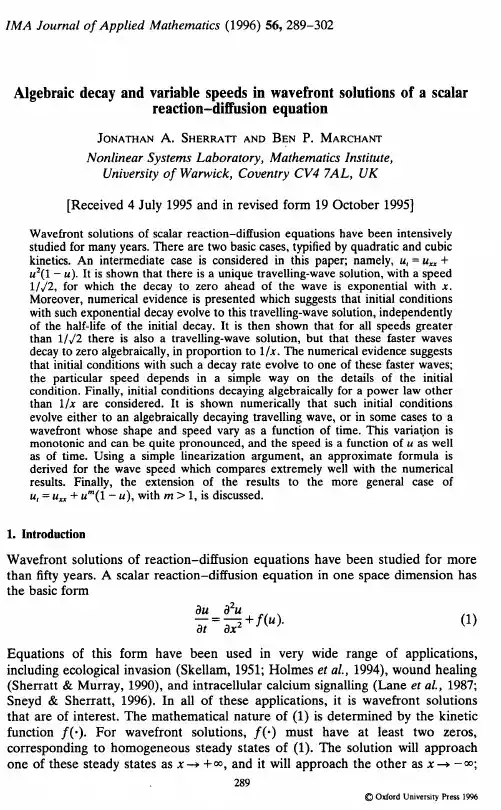
化学分析员面试常见问题化学分析员面试常见问题1、鉴别检查在药品质量控制中的意义及一般杂质检查的主要项目是什么? What are the purposes of drug identification and test? What arethe usual items of drug tests?.2、比色比浊操作应遵循的原则是什么? What are the standard operation procedures for the clarity test?3、试计算葡萄糖重金属检查中标准铅溶液的取用量。
How much of the lead standard solution should be taken for thelimit test for heavy metals in this experiment?4、古蔡氏试砷法中所加各试剂的作用与操作注意点是什么? What precautions should be taken for the limit test for arsenic(AppendixVIII J, method 1)? And what is thefunction for each of the test solutions added?5、根据样品取用量、杂质限量及标准砷溶液的浓度,计算标准砷溶液的取用量。
Figure out the amount of the arsenic standard solution that shouldbe taken for the limit test for arsenic(Appendix VIII J, method 1) (0.0001%) inthis experiment with the specified quantity of2.0 gof sample.6、炽灼残渣测定的成败关键是什么?什么是恒重?What is the key step during the determination of residue onignition? What does ‘ignite or dry to constant weight’ mean?7、盐酸普鲁卡因的鉴别原理是什么?What are the principles of the identification of ProcaineHydrochloride.8、盐酸普鲁卡因注射液中为什么要检查对氨基苯甲酸?Why is the limit of 4-aminobenzoic acid tested for ProcaineHydrochloride?9、薄层色谱法检查药物中有关物质的方法通常有哪几种类型?本实验属于哪种?与其它方法有何异同点? How many kinds of thelimit tests for related compounds arethere? What are the differences between them? Which one is used for the limittest of 4-amino-benzoic acid in ProcaineHydrochloride Injection?10、醋酸氢化可的松的鉴别原理是什么?What are the principles of the identification of hydrocortisoneacetate?11、甾体激素中“其它甾体”检查的意义和常用方法是什么?What are the commonly used method for and the significance of thelimit test for other steroids for the steroidal drugs?12、哪类甾体激素可与四氮唑蓝产生反应,是结构中的何种基团参与了反应,反应式是什么?What kind of steroidal drugs can react with the alkalinetetrazolium blue TS? What is the chemicalreaction equation?13、氯贝丁酯的'鉴别原理是什么?What are the principles of the identification of clofibrate?14、氯贝丁酯中为什么要检查对氯酚?其方法及原理是什么?Why is the limit ofp-Chlorophenol tested for clofibrate?What kind of method is employed for the test and what is the principle?15、气相色谱法检查杂质有哪些方法,试比较各种方法的特点?How many types of methods are there for the test of relatedcompounds by the gas chromatography? What are the differences between them?16、抗生素类药物的鉴别和检查有何特点?What are the characteristics for the identification and tests ofantibiotics?17、钠盐的焰色反应应注意什么?What precautions should be taken during the flame reaction ofsodium salts?18、本品吸收度检查的意义是什么?What is the purpose of the light absorption tests for benzylpenicillinsodium?19、药物晶型测定的常用方法有哪些,各有什么特点?What are the commonly used methods for the test of polymorphism?And what are the characteristics of each of them?20、吸收系数测定方法与要求?What are the standard operation procedures for the establishmentof specific absorbance?21、写出异烟肼与溴酸钾的滴定反应式和滴定度的计算过程。
克级反应要求I find that the concept of reaction stoichiometry, also known as the mole ratio, is crucial in understanding chemical reactions. 在学习化学反应时,我发现摩尔比这一概念是非常重要的。
It plays a vital role in determining the relative amounts of substances involved in a chemical reaction. 它在确定化学反应中涉及的物质相对数量方面发挥着至关重要的作用。
By using stoichiometry, we can calculate the amountof reactants needed or the amount of products formed in a reaction. 通过使用反应计量,我们可以计算反应中所需的反应物量或生成的产物量。
This allows chemists to predict the outcome of a reaction and optimize the conditions for desired results. 这使化学家能够预测反应的结果,并优化所需结果的条件。
When it comes to balancing chemical equations, the stoichiometry of a reaction is essential. 在平衡化学方程式时,反应的摩尔比是至关重要的。
Each element must have an equal number of atoms on both sides of the equation to satisfy the law of conservation of mass. 每种元素在方程式的两侧必须有相同数量的原子,以满足质量守恒定律。
化学反应式英文Chemical Reaction Equations。
Chemical reactions are the processes in which substances, known as reactants, are transformed into different substances, known as products. These reactions are described using chemical reaction equations, which provide a concise representation of the reactants and products involved. In this article, we will explore the fundamentals of chemical reaction equations and their importance in understanding and predicting chemical reactions.A chemical reaction equation consists of two main components: the reactants and the products. The reactants are the substances that undergo a chemical change, while the products are the substances that are formed as a result of the reaction. The reactants are written on the left side of the equation, separated by a plus sign (+), and the products are written on the right side, also separated by a plus sign. An arrow pointing from left to right is used to indicate the direction of the reaction.For example, let's consider the combustion of methane, a common hydrocarbon. The chemical reaction equation for this process is:CH4 + 2O2 → CO2 + 2H2O。
化学反应式英文English:A chemical reaction equation is a symbolic representation of a chemical reaction using chemical formulas. It shows the reactants on the left side of the equation and the products on the right side, separated by an arrow indicating the direction of the reaction. The coefficients in the equation represent the relative amounts of each substance involved in the reaction. Additionally, the equation must be balanced to satisfy the law of conservation of mass, meaning that the same number of atoms of each element must be present on both sides of the equation. This balancing is achieved by adjusting the coefficients until the equation is balanced. Chemical reaction equations are essential in understanding and predicting the outcome of chemical reactions, as they provide a concise and specific description of the chemical change that occurs.中文翻译:化学反应式是使用化学式对化学反应进行象征性表示的方式。